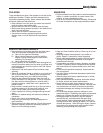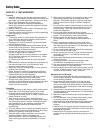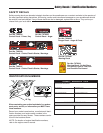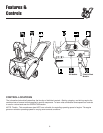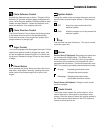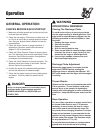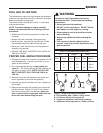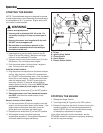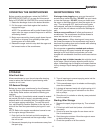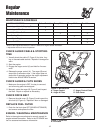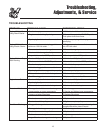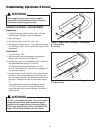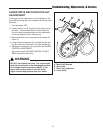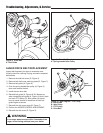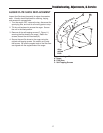
11
Operation
OPERATING THE SNOWTHROWER
Before operating snowthrower, review the CHECKS
BEFORE EACH START UP on page 8 of this manual.
Refer to FEATURES & CONTROLS for control locations.
1. Rotate the discharge chute to the desired direction.
2. Pull the auger control back against the handle to
engage the auger.
NOTE: The snowthrower will be pulled forward by the
auger when the auger contacts the ground or with the
snow being thrown.
3. Begin snow removal by clearing a path down the cen-
ter of walk or driveway, then gradually widen path,
throwing snow off to both sides.
4. Release the auger control to stop both the auger and
the forward motion of the snowthrower.
STORAGE
After Each Use
Allow snowthrower to run a few minutes after clearing
snow to reduce the likelihood of parts freezing while
machine is not is use.
Off-Season Storage
Before you store your snowthrower for the off-season,
read the Service, Maintenance and Storage instructions
in the Safety Rules section and take the following pre-
cautions:
NOTE: Gasoline, if permitted to stand unused for extend-
ed periods (30 days or longer), may develop gummy
deposits which can adversely affect the engine carbure-
tor and cause engine malfunction. To avoid this condi-
tion, add Simplicity Gasoline Stabilizer to the fuel tank, or
drain all fuel from the system before placing unit in stor-
age.
NOTE: Refer to the engine manufacturer’s owner’s man-
ual for engine storage information.
1. Drain fuel from the fuel tank and let the engine run
until all fuel is consumed and the engine stops. Allow
the unit to cool.
2. Disconnect the spark plug wire and secure away from
the spark plug.
SNOWTHROWING TIPS
Discharge chute plugging may occur as the result of
snow build up inside the chute. DO NOT use your hands
to clear the blockage. DO NOT place your hands near
the auger or discharge chute any time the engine is run-
ning. Turn the engine OFF, be sure all moving parts
have stopped, and clear the blockage using a piece of
wood, or put the unit indoors and allow the blockage to
melt.
Various snow conditions will affect performance of
snowthrower. The snowthrower should be allowed to
move into the snow at its’ own pace.
Wet, heavy snow — When clearing wet, heavy snow,
the forward movement of the snowthrower may have to
be slowed by pushing down on the handle while allowing
engine to operate at full throttle.
Do not operate on gravel or crushed rock surfaces.
Avoid picking up this type of material with auger since
damage to unit could result and particles can be dis-
charged with considerable force that could cause serious
injury.
Always be alert to hidden hazards that might be struck
by the auger. Should a foreign object be struck by the
auger, immediately stop the engine and inspect machine
for any damage. Repair damage before continuing oper-
ation.
3. Tape all openings to prevent spraying water into the
exhaust or air intakes.
4. Tilt the snowthrower up on its wheels and thoroughly
clean the underside.
5. Lubricate all exposed metal with a light coating of oil.
DO NOT place any type of lubrication on the drive
belt or pulleys.
6. Store the unit in a shelter or other dry area protected
from the weather.
Starting After Storage
1. Remove the spark plug and wipe dry. Then reinstall
plug.
2. Fill fuel tank with fresh fuel (unless a fuel stabilizer
was used).
3. Check to be sure the engine fins are clean and air
flow is unobstructed.
4. Start the engine outdoors. Allow the engine to warm
up before blowing snow.
5. Check the operation of all the controls.



